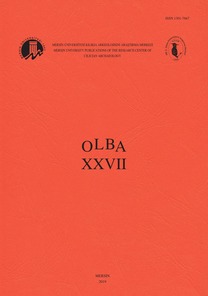Kilikya’da Geç Antik Dönem Kırsal Yerleşimleri: Kanytellis Örneği
kırsal yerleşim
Kanytellis as a Case Study for Late Antique Rural Settlements
rural settlement,
___
Baird 2004 Baird, D., “Settlement Expansion on the Konya Plain, Anatolis: 5th-7th Centuries A.D”, Recent Research on the Late Antique Countryside, (ed. Bowden, W and L. Lavan and C. Machado), Leiden,, 219-247. Banaji 2001 Banaji, J., Agrarian Change in the Late Antiquity, Gold Labor and Aristocratic Dominance, Oxford. Bayliss 2004 Bayliss, R., Provincial Cilicia and the Archaeology of Temple Conversion, BAR International Series 1281, Oxford. Bell 1906 Bell, G. L., “Notes on a Journey through Cilicia and Lycaonia”, Revue Archéologique I, 1906, 402-411. Ceylan 2004 Ceylan B., “Hıristiyanlık Merkezleri Olarak Anadolu Kentleri”, Uluslararası Türk Dünyası İnanç Merkezleri Kongresi Bildirileri, Ankara, 319-328. Ceylan 2007 Ceylan, B., “Episkopeia in Asia Minor”, Housing in Late Antiquity, from Palaces to Shops (ed. L. Lavan, L. Özgenel, A. Sarantis), Leiden, 169-196. Chavarria - Lewit 2004 Chavarria A. - Lewit, T., “Archaeological Research on the Late Antique Countryside: A Bibliographic Essay”, Recent Research on the Late Antique Contryside (ed. Bowden, W and L. Lavan, C. Machado), Leiden, 3-54. Dagron – Callot 1998 Dagron, G. – Callot, O., “Les Batisseurs Isaurien chez eux Notes sur Trios Sites des Environs Silifke”, AETOS, Studies in Honour of Cyril Mango, (ed. Sevcenko, I., I. Hutter), Stuttgart, 55-70. Durugönül 1998 Durugönül, S., Türme und Siedlungen im Rauhen Kilikien, Eine Untersuchungen zu den archäologischen Hinterlassenschafen im olbischen Territorium, Asia Minor Studien, Band 28. Eichner 2005 Eichner, I., “Frühbyzantinische Wohnhauser in Kilikien. Arbeit über die Kampagne 2003 und einige Ergebnisse des Projectes”, Araştırma Sonuçları Toplantısı 22, 201-212. Eyice 1976/1977 Eyice, S., “Silifke Çevresinde İncelemeler, KanlıDivan (Kanytelleis- Kanytellideis) Bazilikaları”,Anadolu Araştırmaları 4-5, 413-441. Eyice 1980 Eyice, S., “Silifke ve Dolaylarında Yapılan Topraküstü Arkeolojik Araştırmalar Raporu”, Belleten 44, 111-124. Eyice 1982 Eyice, S., “Une Site Byzantine de la Cilicie: Okuzlu et ses Basiliques”, Rayonnement Grec, Hommagés a Charles Delvoye (ed. Hadermann, L., Raepaet G.M), Bruksel, 355-367. Forsyth 1961 Forsyth, G.H., “An Early Byzantine Church at Kanlıdivane in Cilicia”,. Essays in Honour of Erwin Panofsky, De Atribus Opuscula XL, (ed. Meiss, M.) NewYork, 127-137. Foss 1995 Foss, C., “The Near Eastern Countryside in Late Antiquity: a review article”, The Roman and Byzantine Near East, Some Recent Archaeological Research, JRA suppl 14 (ed. Humphrey, J.H), Ann Arbor, 213-234. Haldon 1997 Haldon, J.F., Byzantium in the Seventh Century, the Transformation of a Culture, Cambridge. Hicks 1891 Hicks, E.L., “Inscriptions From Western Cilicia”, Journal of Hellenic Studies XII, 226-237. Hild 1984 Hild, F. - Hellenkemper, H. - Hellenkemper Salies, G., Kommagene- Kilikien-Isaurien, Reallexikon zur Byzantinischen Kunst IV, 208- 211. Hill 1985 Hill, S., “Matronianus Comes Isauriae: An Inscription from an Early Byzantine Basilika at Yanıkhan, Rough Cilicia”, Anatolian Studies 35, 93-97. Hill 1996 Hill, S., The Early Byzantine Churches of Cilicia and Isauria, London. Hirschfeld 1997 Hirschfeld, Y., “Farms and Villages in Byzantine Palestine”, Dumbarton Oaks Papers 51, 33-51. Mango 1981 Mango, C., “Daily Life in Byzantium”, Jahrbuch der Österreichischen Byzantinischen Gesellsschaft,31/1, 353-387. Mietke 1999 Mietke, G. - Westphalen, S., “Basilika 3 in Kanlıdivane (Kanytelis)”, Istanbuler Mitteilungen 49, 517-526. Tate 1992a Tate, G., Les Campaignes de La Syrie du Nord du IIe Au VIIe siécle, Paris, 95-101. Tchalenko 1953 Tchalenko, G., Villages Antiques de la Syrie du Nord, Paris. Vanhaverbeke - Martes 2004 Vanhaverbeke, H. - F. Martes, vd., “Late Antiquity in the Territory of Sagalassos”, Recent Research on the Late Antique Countryside, (ed. Bowden, W and L. Lavan and C. Machado), Leiden, 219-247. Ward-Perkins 2000 Ward-Perkins, B., “Land, Labour and Settlement”, Cambridge Ancient History XIV, Late Antiquity: Empire and Successors, A.D. 425-600, (ed. Cameron, A.K., P. Garnsey), Cambridge, 315-345. Ward-Perkins 2001 Ward-Perkins, B., “Specialisation, Trade and Prosperity: An Overview of the Economy of the Late AntiqueEastern Mediterranean”, Economy and Exchange in the East Mediterranean during Late Antiquity, (ed. Kingsley, S., M. Decker), Oxford, 166-178. Wittaker – Garnsey 1998 Wittaker, C.R. - Garnsey, P., “Rural Life in the Later Empire”, Cambridge Ancient History XIII,The Late Empire, AD 337-425 (ed. Cameron, A.K., P. Garnsey), Cambridge, 277-311.- ISSN: 1301-7667
- Yayın Aralığı: 1
- Başlangıç: 1998
- Yayıncı: Kilikia Arkeolojisini Araştırma Merkezi
Alahan’da (Isaurya) Bir Roma Kentinin Keşfi
Hugh ELTON, Mark JACKSON, Gabriele MIETKE, James NEWHARD, Lale ÖZGENEL, Emma TWIGGER
Antike Autoren über Kilikien. Überlegungen am Beispiel der Stadt Tarsos
Eliaussa Sebaste’de (Kilikia) Bulunan Tapınak İçin Yeni Bir Kült Önerisi
ALAHAN'DA (ISAURYA) BİR ROMA KENTİNİN KEŞFİ
Hugh ELTON, Mark JACKSON, Gabriele MIETKE, James NEWHARD, Lale ÖZGENEL, Emma TWİGGER
Kilikia Hakkında Yazan Antik Yazarlar. Tarsus Şehri Örneğinde Düşünceler
Tarsuslu Nectarius’un İlk Constantinopolis Patriği Olarak Seçilmesi
TARSUSLU NECTARIUS’UN İLK CONSTANTINOPOLIS PATRİĞİ OLARAK SEÇİLMESİ
Ein neuer Kultvorschlag für den Tempel in Elaiussa Sebaste (Kilikien)
Roma Döneminden Bizans Dönemine Kilikia’da Seramik Üretimi. Elaiussa Sebaste’den Yeni Veriler
